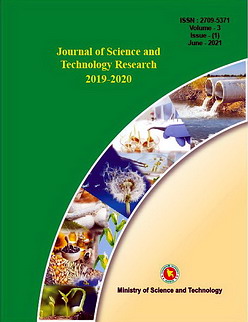Molecular Characterization and Antibiogram Profiling of the Isolated Food-Borne Pathogenic Bacteria on Fresh-Cut Salad Vegetables
DOI:
https://doi.org/10.3329/jscitr.v3i1.62809Keywords:
16S rRNA; Fresh-Cut salad vegetables; Multidrug-Resistance; Antibacterial activityAbstract
Fresh cut salad vegetables (FCSV) play a significant role in our healthy and balance diet. The consumption of raw salad vegetables are vectors for the transmission of various infectious diseases, which is a public health issue in developing and developed world. Therefore, the aim of this present study was to evaluate the microbial contamination of ready-to-eat salad vegetables sold in different local vendors in Kushtia and Jhenaidah districts in Bangladesh. A total of 21different ready-to-eat FCSV samples were collected aseptically and analyzed immediately in our laboratory. A total viable bacterial count (TVBC) was enumerated up to 107 CFU/g in the tested samples. The highest number (3.01±1.4 × 107 CFU/g) of TVBC was found in Coriander leaf (Coriandrum sativum) and least microbial load (2.33±1.05 × 105 CFU/g) was observed in Red spinach. On the basis of morphological differentiation randomly selected bacterial isolates (Aeromonas sp., Citrobacter sp., Enterobacter sp., Pectobacterium sp., and Staphylococcus sp.) were identified by 16S rRNA gene sequencing. Moreover, most of the isolates were showed as multidrug-resistant bacteria via the antibiogram profiling testing. The overall antimicrobial susceptibility profile showed that the tested bacterial isolates were resistant against Erythromycin (15μ g), Penicillin G (10 unites), Nalidixic acid (30 μg), Ceftriaxone (30 μg), Ceftazidime (30 μg), susceptible against Kanamycin (30 μg), Polymyxin B (300 units), CO-Trimoxazole (25 μg), Colistin (10 μg), Doxycycline (30 μg) and intermediate against Nalidixic acid (30 μg), CO-Trimoxazole (25 μg), and Kanamycin (30 μg). Pathogenic bacterial contamination of FCSV, hygienic practices should be maintained before consumption.
J. of Sci. and Tech. Res. 3(1): 77-84, 2021
118
206
Downloads
Published
How to Cite
Issue
Section
License
Copyright (c) 2021 MA Kadir, MC Ali, W Hassan, MM Rahman

This work is licensed under a Creative Commons Attribution 4.0 International License.




